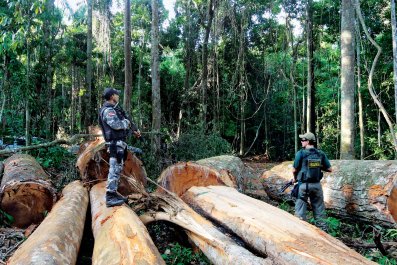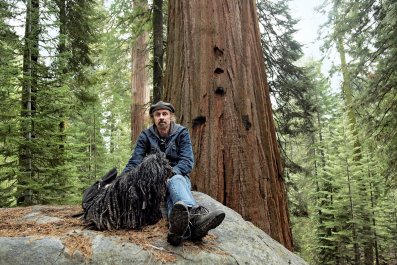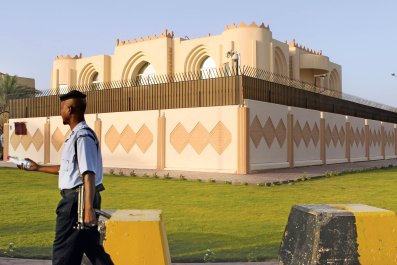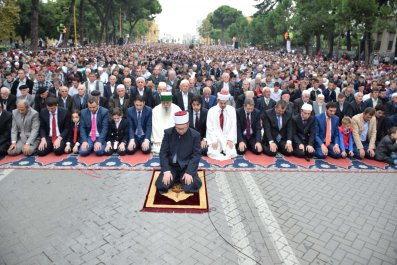One morning, citizens of this small Tuscan city, tucked away on the western slopes of the Apuan Alps in northern Italy, awoke to a strange protest. Grievance signs in blood-red letters had appeared overnight on the city's statutes. "They have even taken my underwear," read the sign strung around the neck of Moretta (Little Brown Girl); "Quarries to the Carrarini," cried the note on the heart of the anarchist Alberto Meschi, one of the city's most famous sons, who campaigned for better conditions for quarry workers. A few hours later, all the signs had been swiftly removed.
Carrara is home to the world's largest marble field, formed in the Apuan Alps over 200 million years. From the air, the marble mountains look as though they were covered in snow. From close up, the high vertical faces and giant benches of the open-cast excavations are like colossal white cathedrals in a moonscape. The landscape provided the backdrop for a car chase in the 2008 James Bond film Quantum of Solace.
These quarries have been mined since Roman times. Under the orders of Emperor Augustus, slaves began working them in the first century BC, so that rich villas and public monuments – including Trajan's Column and part of the Pantheon in Rome – could be covered in the whitest, most sought-after marble in the world. Some quarries still bear the marks of the slaves' chisels. Michelangelo came here at the turn of the 16th century to select stones for his iconic David and Pietà statues. From Henry Moore to Louise Bourgeois and Isamu Noguchi, countless other artists across centuries and continents have been bewitched by the stone. The cathedrals of Florence and Siena, St Petersburg's Hermitage museum, Marble Arch in London and Washington's Kennedy Centre are all made from this celebrated marble.
THE 'WHITE GOLD' CURSE
For centuries, Carrara's marble has been the backbone of the region's economy and its pride. But now it has turned into a curse. The irreplaceable stone is being undersold, most of the small workshops where marble was carved have disappeared; a rare craft is dying and the environment is wrecked.
This is a business with a yearly turnover of between €7–800m, according to the Guardia di Finanza police, who are examining the accounts of the industry. The only beneficiaries, however, are a few powerful families and businesses, while the rest of the town is blighted by the side effects of excavation – especially the dust and flooding.
Despite its extraordinary natural resources, Carrara, a town of 66,000 inhabitants, is one of the poorest in Tuscany and one of the most heavily indebted in the country. The streets are dotted with abandoned buildings and, for years, scaffolding has hidden hotels and theatres (including the one where Puccini directed Tosca) because there are no public funds to complete restoration work. Up until now, the local administration has not taken any measures to "touch the privilege of the planet marble," as local journalist Massimo Braglia puts it.
But now, for the first time in over a century, the people of Carrara, as well as smaller neighbouring marble towns such as Massa, Seravezza and Pietrasanta, are fighting back. Over the past year, they have signed petitions, held meetings and organised demonstrations, and taken their grievances to court and to the regional government.
The last time Carrarini dared to revolt was in 1894, says a local historian called Beniamino Gemignani. On that occasion, 454 people were tried and handed harsh sentences for claiming that the marble belonged to the town and not to a handful of families. "That was the last time that this sentiment was expressed publicly," says Gemignani. "But it didn't die, it lodged itself into the unconscious of the town. And now it has emerged again – loudly and clearly."
This time, the people of Carrara might have been heard. On 10 March, against all odds, Tuscany's Regional Assembly passed a law that should bring added value to the city. But residents are only cautiously optimistic; it would not be the first time such a law has been ignored or weakened by loopholes.

BIN LADEN BUYS TUSCANY
"Marble is in the DNA of the people of Carrara," says Gemignani. "It represents our history, our skills and even our wounds (for working the marble). A pact of reciprocal respect bound people to their mountains… But now it's all gone."
The pact has been broken by globalisation, market forces and new excavation methods. In 1920, less than 100,000 tons a year was extracted from the area's quarries. Today, the figure is more than five million, as local marble barons try to compete on price with producers in China, Russia and India by carving up the mountains at a relentless pace, using diamond saws and huge mechanical shovels.
Residents object that the industry's insatiable demand for quantity is devaluing their precious stone – underselling it in bulk as a mere building stone instead of recognising it as an artist's medium. When this summer, the Bin Laden family quietly entered this very Italian industry, local fears seemed to be confirmed. In August, CPC Marble and Granite Ltd, a company constituted by the brothers and cousins of the deceased al-Qaida leader, Osama bin Laden, paid €45m to acquire 7.5% of the concessions of Carrara's 81 active quarries (there are some 100 additional quarries in the area).
The conglomerate already controls 26 quarries around the world and has had longstanding commercial relationships with Carrara marble industrialists. But this operation ensures that the group now controls the supply of the "white" Carrara, which is experiencing a new golden era in Saudi Arabia, as well as in China and India.
The deal marks the first time a foreign group – let alone one with such a loaded name – owns shares in Carrara marble district. Some greeted the news with disbelief, bemoaning the
"Arabisation of the quarries of Michelangelo", but others hailed the process with optimism, scenting the millions of euros in investment and a potential boost for employment.
"The deal shows that local marble families and businesses didn't care enough to protect Michelangelo's mountains," says Eros Tetti, 37, founder of an association for the protection of the mountains. "They let foreign companies take away our raw resources. Carrara marble is one of the most precious kinds in the world. Because it is very soft, it is best used to create statues and works of art. We don't want it to be taken away and used to build new skyscrapers in Saudi Arabia. We want it to stay here and be used to make art."
Mayor Angelo Zubbani, on the other hand, enthusiastically supports the transaction. He says he is "optimistic" that it will create much-needed new jobs in Carrara and confident that the group will process the marble there, although no industrial plan has been presented. In 2013 alone, the mayor pointed out, the group placed orders for about €40m and used local sawmills to cut the blocks into slabs. In a town hit hard by the recession, this was a winning argument.
"The odd thing is not that the Bin Laden family has acquired the quarry concessions, but that this doesn't seem to play any role in the protest that has been gaining momentum," muses Gemignani. It is, he adds, "more a measure of the disenchantment and anger with the marble barons and the local administration that people believe that any intervention is preferable to the status quo".
The status quo doesn't speak well for the local companies and administration. Marble extractors pay a concession fee to the city – 8% of the average value of the excavated stone. In May, the mayor, his city council and business associations representatives will appear in court to learn whether they will be sent to trial for allegedly agreeing in 2009 to base fees on values significantly lower than the market value of the stone, a move that may have cost the town €25m.
Some companies have managed to avoid the concession fee, invoking an ancient law. In 1751, Maria Teresa d'Este, Duchess of Massa and Carrara and the owner of the land, granted local families the right to exploit the quarries and pass on the concession to their descendants. For 264 years, 30% of quarries have been subject to this archaic law; they are treated as private properties and pay no fees. Some of the concessionaires are also being investigated for a massive flow of money from Carrara into foreign companies and Swiss banks, and for the systematic under-invoicing of the marble. The investigation has led to the request for the indictment of 59 entrepreneurs.

DEATH OF AN ART
Fabrizio Lorenzani, 52, a sculptor and teacher at the country's only marble school, closes the door for the last time of the studio where he and his wife have spent years working. His is the last studio in the area to have been turned into a warehouse to store marble blocks awaiting shipment. "Ours was a place for dreaming... And now it is gone. Michelangelo's marble city has no room for its artists," he says.
At the turn of the century, Carrara was one of the fastest-growing cities in Italy – a vibrant centre of culture and art, known worldwide not only for its exceptional marble, but also for its master sculptors, skilled artisans and stonemasons. Trained at the city's Academy of Fine Arts (the oldest one in Italy) and the at the Marble School, they executed original commissions for renowned artists, reproduced copies of masterpieces and made decorative objects. Most of the marble fireplaces in London were made in Carrara's workshops – including those in 10 Downing Street.
So renowned were Carrara's craftsmen that marble, granite and onyx quarried all over the world was brought there for shaping and polishing into slabs for architectural facing and paving, and for carving into decorative objects. Marble entrepreneurs invested in the city, building theatres and hospitals, developing skills, infrastructures and new technologies. There was social inequality, quarry work was dangerous and workers were exploited, but most people were employed somehow in the industry – mining, processing, transporting, transforming or producing artistic work.
Carrara's fate started to change after the Second World War. The quarries were in new hands – some because the Fascist leader Benito Mussolini had stripped them from the old families, others simply through generational change. New technologies dramatically increased production while reducing the workforce. Still, throughout the 1950s, some 16,000 people were employed in the quarries and many more in related activities.
Nowadays, fewer than 1,000 people work in the quarries and the industry at large employs barely 7–10% of the region's population. Only a handful of workshops and studios remain in the city. Even Carrara's own marble is rarely finished there, as overseas labour is cheaper. The modern-day marble barons and multinationals are not interested in investing back into the city and training new generations of artisans – and the marble expertise developed over generations is rapidly unravelling.
Lorenzani and his wife have yet to find a new studio and the Marble School where he teaches – the only one in the country – has only 80 students enrolled this year, many of whom are not locals.
MOUNTAINS AND MEMORY
"Whenever I look at our mountains, I see more destruction: their shapes are altered, their peaks are disappearing," says Eros Tetti, who founded the campaign group Salviamo le Apuane (Save the Apuan Alps) in 2009. The association, which now has more than 10,500 members, has been studying the impact of the quarries and campaigning for the preservation of the region's natural and cultural heritage.
"When they are destroying the landscape, they are also destroying a large part of our lives and our past. If you walk in our mountains, you'll see that people don't work and live there any longer. Tourism and gastronomy had been a main part of our economy, but now it's all gone because of the quarries."
Modern mining techniques have not only increased marble extraction, but also the amount of broken stones and debris generated in the process. Of the five million tons of marble extracted each year, only 1.2 million is made of blocks; the remaining 3.8 million is fragments. Quarrying companies used to pour this debris along the flanks of the mountains, "painting them in white", but in the early 1990s multinationals such as Omya from Switzerland and Imerys from France discovered that far from being waste, these by-products were worth a fortune once cleaned and ground into a fine powder.
The powder, calcium carbonate, is used as filler in everything from toothpaste, cosmetics and foodstuffs to paint and paper. While the most expensive purest white statuario marble is worth between €2,700 and €3,000 a ton, processed calcium carbonate yields as much as €9,800 for 100kg on the English stock market. And the cost to these multinationals is a mere €4.20 a ton. Because the debris is so valuable, there is no incentive to carefully carve out the blocks of marble. Every day, 500 to 800 mega-trucks transport marble blocks and fragments from the quarries to the port and the processing plants.
Environmentalists worry that this unbridled exploitation is irredeemably mutilating their mountains. In 2011, a 40,000-hectare area between the provinces of Massa-Carrara and Lucca in the Apuan Alps was declared a UNESCO geopark to protect its exceptional fauna and flora and its unique geological landscape with deep crevasses and an intricate network of caves and karsts. Yet there are still some 50 active quarries there, in violation of the law.
"Even Focolaccia, the highest pass in the Apuans, between Mount Cavallo and Mount Tambura, is now an open quarry – the old salt route ran through that pass," says Tetti.
In addition, intensive quarrying is affecting the hydrogeological cycles and destabilising the mountains, and marble waste is affecting waterways. The Carrione river, which flows through many quarries, is now choked with detritus, causing devastating floods.
In 2014, Tuscany's regional assembly adopted its Regional Landscape Plan, based on a different concept of territorial governance. The idea was to prevent the Carrara-isation of the rest of the Apuan Alps and calls for the gradual closure of the quarries in the geopark, a ban on excavation above 1,200m and near water sources, and the replacement of mining in the park with a sustainable economy that would benefit the entire community.
As a result of aggressive lobbying by marble companies in the area, a watered-down version is now being discussed. "Even the region is cowed by the marble barons," says Riccardo Canesi, 58, a geographer and former Chief Secretary of the Ministry for the Environment.
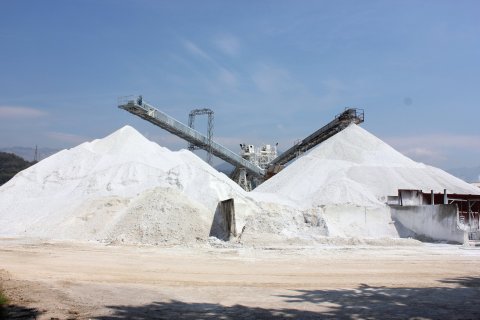
TEXTBOOK DESTRUCTION
"Carrara will be studied in future textbooks as a prime example of economic and environmental regression: a century ago, we had the complete marble chain (mining, processing, transformation and artistic craftsmanship on site), now we have a mining monoculture aimed solely at the mass extraction and export of the raw marble, and, even worse of the calcium carbonate. It is incredible to find at the dawn of the third millennium, within the eighth-largest economy on the planet, such a shocking example of proto-industrial colonial style economy," says Canesi.
On 10 March, however, Tuscany's regional assembly approved a law that might make Canesi reassess his prediction. The law declared the marble fields the "indisposable property" of the citizens of Carrara, ending the old Este privilege. In addition, all quarries' concessions will be gradually reassigned through tender and only to those who commit to process locally at least 50% of the marble they extract.
This could be an epochal decision, and the reaction of the industrialists has been explosive – furious, stunned, unable to imagine that their quarries might be auctioned off. And their lawyers are already getting ready for litigation.
Carrara would rejoice, if its people had not become cautious through experience. Past attempts at legislating over marble were quietly dismissed through a series of amendments in favour of the industrialists. Now, with the combined weight of Europe and the Region leaning on him, the mayor has declared his commitment to returning the quarries to the town. However, circumventing EU regulations, the Region has already allowed extensions to the enforcement of this new law for a minimum of seven to a maximum of 25 years.
Will Carrara see more than a few crumbs from a volume of business estimated at close to €800m a year? Will there be jobs for her people? Will they again have their theatres, their busy studios, a river that flows, but doesn't kill? Will they rest assured that their mountains are not depleted at a frantic pace and transported, in block, to other parts of the world?






